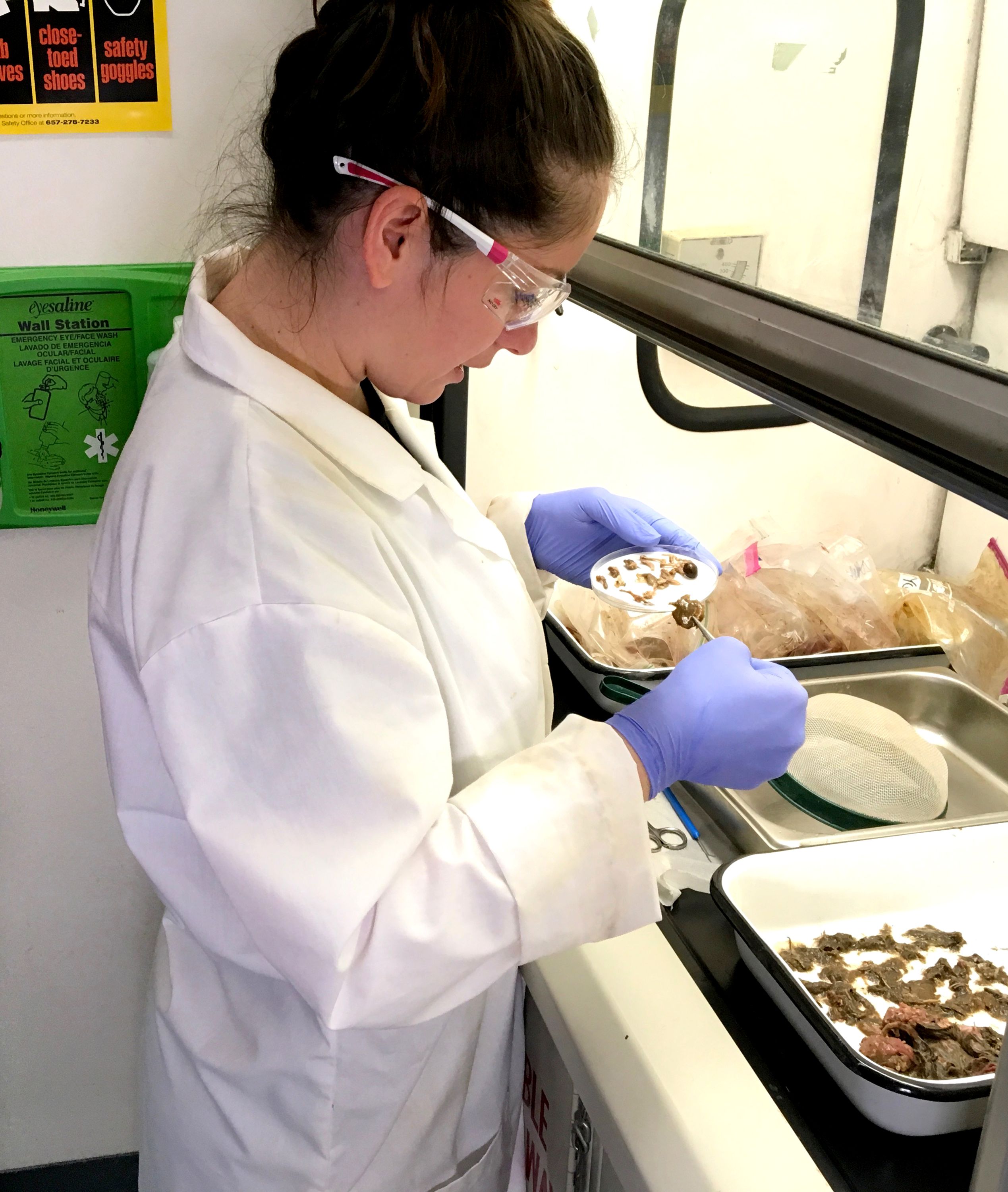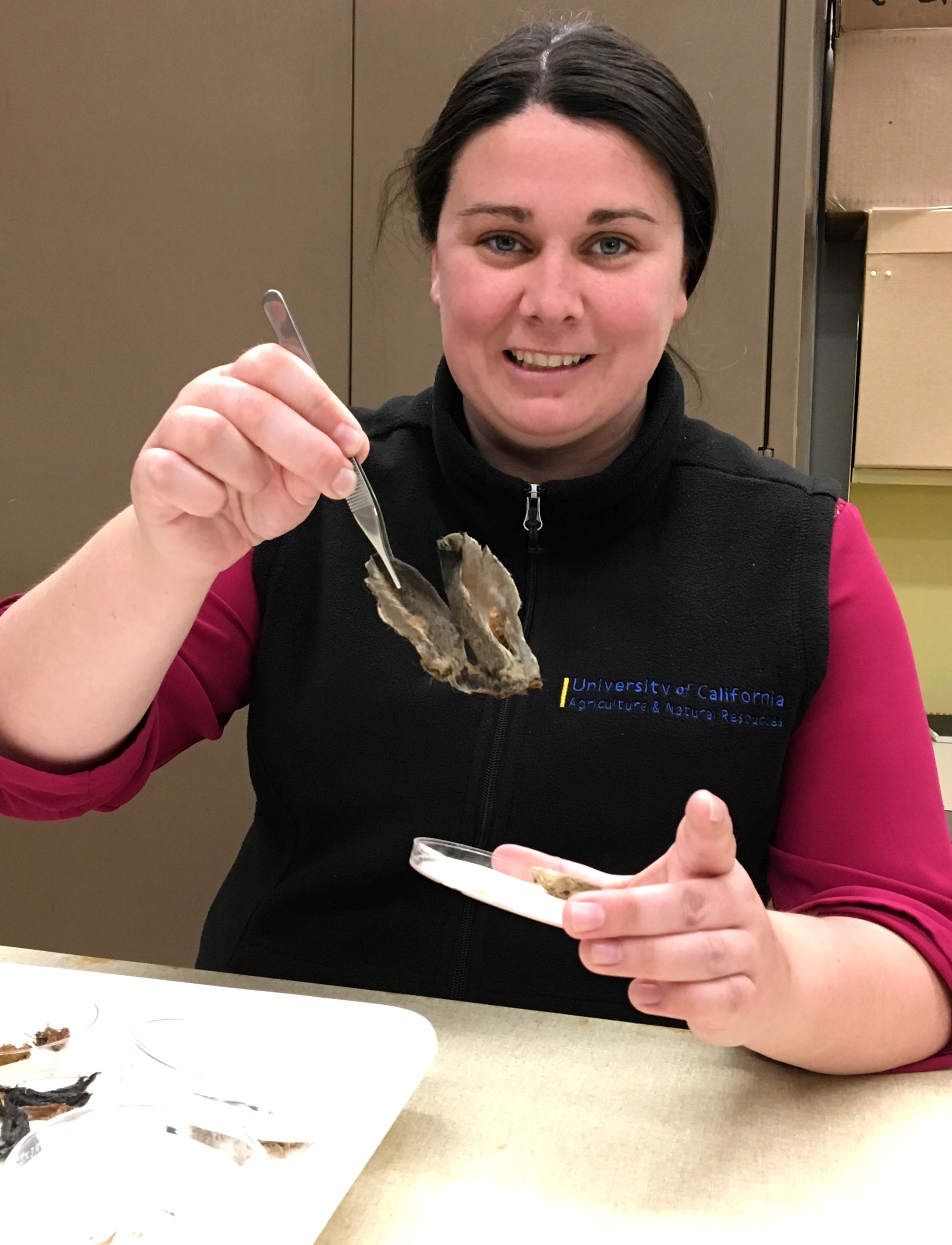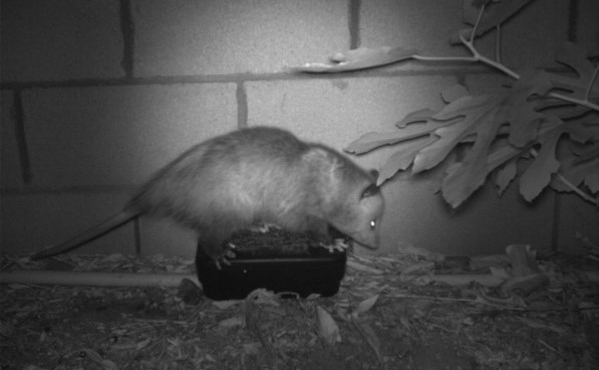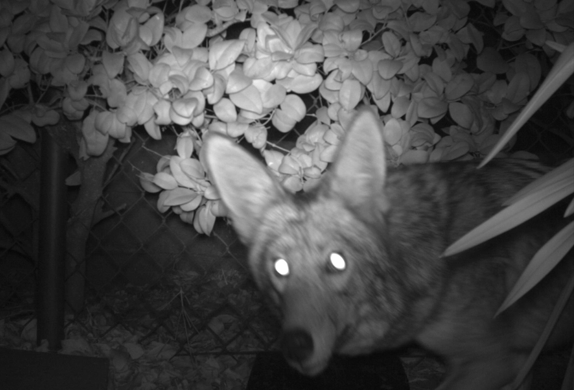Learning to Manage – and Live with – Coyotes in Southern California

Danielle Martinez picks through a coyote's stomach contents.
Forrest Gump believed life was like a box of chocolates – you never know what you’re going to get inside.
It’s much the same for graduate student Danielle Martinez, except she isn’t reaching for tasty chocolates.
She’s digging into coyote stomachs.
“It’s just like opening your presents at Christmas,” said Martinez, with more enthusiasm than most people would muster after sifting through the half-digested contents of more than 100 coyote stomachs. “You really do never know what you’re going to find.”
Martinez, who is getting her master’s degree at California State University, Fullerton, is part of a larger research effort studying urban wildlife in Southern California. Niamh Quinn, a wildlife ecologist with the University of California Division of Agriculture and Natural Resources, is leading the project.
“It’s a melting pot of crazy, unanswered questions,” Quinn said. “Southern California has huge coyote issues, and people who hate coyotes and people who love coyotes and they’re literally living next door to each other.”
What’s missing is some of the basic science needed to help people manage and co-exist with coyotes and other urban wildlife, and that’s where Quinn and her colleagues are trying to fill in the gaps.
What Do Coyotes Eat?
There are a lot of basic facts about coyote ecology scientists just don’t know, and one is their diet. While there have been scat studies where people pick through poo to see what they’ve eaten, Quinn said those have limitations.
“It’s not the identification of the parts within the scat that are inaccurate,” she explained, “it’s the identification of the scat itself. If you have a coyote eating a lot of dog food, its scat is likely to be mistaken for a dog’s.”
And coyotes do eat everything, as Martinez can attest.

Niamh Quinn shows some of what the coyote diet study has found - in this case, rabbit ears.
“I think the strangest thing I’ve found was a piece of a baseball,” she said. “And I’ve found parts of a shoe, straw wrappers and a piece of car seat once.”
The animals’ diet matters because some coyotes are being killed by rodenticides put out to kill rats, which makes sense if coyotes eat a lot of rats. But do they?
“There was zero scientific evidence that coyotes eat commensal rodents,” Quinn said, referring to the three types of mice and rats that live in close proximity to humans – Norway rats, roof rats and house mice. “And if coyotes don’t eat rats, how are they getting exposed to rodenticides?”
So far, the stomach contents have shown roof rats to be about 8 percent of the Southern California coyote diet.
“Coyotes are omnivores,” Quinn said. “They eat everything. So they could be picking up things that are already dead. We don’t know.”
To figure out what those things are, Quinn’s team collects a lot of coyote carcasses with the help of CalTrans, local police departments and professional pest managers. Each animal is autopsied and the stomachs saved.
Martinez empties the contents of those stomachs onto a screen and washes away the goop, then picks out bones and other identifiable parts onto small trays. She’s become quite expert at identifying the coyote’s last meal, from cats to rabbits to gophers. Another team member blends the remainder together for later DNA analysis.
And with 100 stomachs done, Martinez only has about 300 more to go.
The Problem with Rodenticides
In 2014, the state of California restricted the use of four anticoagulant rodenticides to licensed pesticide applicators to try to reduce wildlife losses from unintentional poisoning. The state’s Department of Fish and Wildlife has documented 400 cases of wildlife poisoning from rodenticides since 1994.
Quinn is trying to document how those happen.
“How does it get from the point of origin to the point of exposure?” she asked. “We know there’s exposure to wildlife, but there’s not a lot of science about how it happens. And if we don’t know how it’s broken, we can’t fix it.”
So a second part of the research is to see just which critters do visit the bait stations that are commonly set out to control rats. Another member of Quinn’s research team set up bait stations, loaded with bait but no poison, in the backyards of dozens of Southern California homes. Some were on the ground and some elevated on fences or trees, but all had cameras trained on them.

An opossum visiting a bait station.
“In the first 30 days, we got rats and a possum, a skunk, an owl a coyote and even a bobcat,” Quinn said.
Integrated pest management can help control rodent pests. Steps like clearing away ivy and woodpiles can eliminate their nesting sites. Good sanitation can take away their food supply, and sealing up holes and cracks can keep them out of homes and schools and businesses.
But because small rodents can reproduce rapidly – they do breed like rabbits after all – Quinn believes some rodenticide use will be needed to keep populations in check.
“I really don’t think California without rodenticides looks very good,” she said. “But we do need better educated professionals and better educated homeowners to reduce unintentional exposure.”
She also hopes to better understand if the wildlife poisonings are having a population-level effect, and if they’re having sub-lethal effects.
Help Wanted: Coyote Hazers

A coyote in a backyard.
A third area of research will begin this fall, and its focused on human-coyote interactions.
In this part of the study, Quinn’s team are going to collar 20 coyotes in different communities and then let them settle back in to their normal routines. Using observations and GPS and accelerometer data collected by the collars, the researchers are going to get a picture of the animals’ day-to-day activities and routines.
Then a dedicated group of community volunteers are going to annoy those coyotes.
“They are going to intersect with the coyote at some period in the day and start to scream at the coyote and wave their arms,” Quinn said.
Yelling and arm-waving is a form of wildlife hazing, and it’s recommended now for people who encounter wild coyotes. But there’s no science to show it’s effective.
“Did the coyote run away with its tail between its legs, or did it approach or anything in between?” Quinn said. “With the collar data, we’ll be able to see if their behavior changes. Do they change their routine so they intersect with humans less?”
That’s the hope, but not the only possibility.
“They could become inured to the hazing,” Quinn said. “Or maybe won’t react in the first place, and they should.”
What scientists do know is that human-coyote confrontations are increasing in Southern California, and that with the area’s geography – large communities surrounded or bisected with wooded canyons – those interactions are inevitable.
“It’s unrealistic to expect not to have an encounter with a coyote in Southern California,” Quinn said. “And it’s a very emotional issue, and rightly so. People’s pets are being eaten, and people are being bitten. We had three people bitten in a six-month period, and a bite by a wild animal should be a freak event.”
And while the researchers are hoping to find ways to modify the animals’ behavior to reduce those encounters, Quinn believes humans’ behaviors will change, too.
“Twenty years ago, nobody locked their doors and now everybody does,” she said. “And people used to walk their dogs off-leash and leave their pets in their backyards. But that may change.”
Furry Pests Present Unique Challenges
Coyotes and rats fall into a category known as vertebrate pests – literally pests with a backbone – and they present unique challenges for pest managers. There are no fan clubs or support groups for insect or disease pests like stink bugs or root rots, but there are for coyotes.
And wild horses. And feral cat colonies.
The Western Governors’ Association, for instance, just included feral cats on its list of 50 invasive species that threaten Western ecosystems. Feral hogs, European starlings and the water-dwelling rodent nutria are also on the list.
“When you’re looking at managing a species like wild horses, it’s highly charged,” Quinn said. “I’ve had colleagues get death threats.”
And that’s why there’s such a need for good science. No one can develop an effective management practice if they don’t know the basic ecology of the issue.
“I was hired to solve a problem, and man do we have a problem,” Quinn said. “It’s like a huge mosaic puzzle, and I feel like I just have the first four pieces in the corners. Now we have to fill in everything between.”